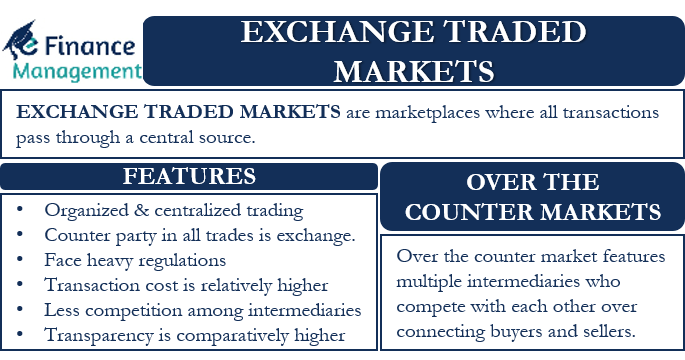Exchange-Traded Markets are the marketplaces where all the transactions pass through a central source. Or, we can say it is the intermediary or the platform or the conduit that connects the buyer and seller. And all the market transactions are necessarily routed through it. Though it is an intermediary or a conduit, or an exchange holds and yields immense power and control over the trade and its constituents. It also means that the exchange takes up all the responsibility to ensure the parties honor the contractual obligations. NYSE (New York Stock Exchange) and NASDAQ are good examples of exchange-traded markets.
Let us understand them with the help of a simple everyday example.
Suppose Mr. A is planning to sell his car. He can either go to a car selling website, which will have its own rules and regulations, as well as charge a fee to sell the car. Another option for Mr. A is to give an ad for selling the car and wait for the buyers to approach themselves.
Here, the car selling website is similar to the exchange-traded markets. On the other hand, selling the car through ads, or without any rules and regulations, is like selling through an OTC market (discussed later).
Exchange Traded Markets – More Details
The primary purpose of exchange-traded markets is to ensure fair, efficient, and orderly trading.
In an exchange-traded market, the buyers and sellers trade securities, commodities, derivatives, and more such instruments of the listed firms. The market factors (demand and supply) decide the prices of the securities, including shares, debentures, bonds, and more securities, that trade on such markets.
Also Read: Stock Exchange
These markets feature the association of persons. Such people will get the registration with the exchange and are member brokers. The exchange has set rules for the brokers and companies whose securities are listed for trade.
The firms that want their shares to list on these markets need to abide by the market rules and regulations. They also need to regularly provide information to the exchange. This information includes financial reports, audited statements, any major change in the management, any key development about the project, etc.
Initially, these exchanges had an open outcry’ system, something similar to your local vegetable market, where the seller shouts the price. In that system, the exchange was the trading floor or the market place and the member brokers had to be physically present to transact and trade on behalf of their clients. But now, most of the trading is electronic and quick, which means you trade from anywhere, and thus there is no need to be physically present to make a trade.
Amsterdam is the oldest exchange-traded market that was established in 1602. At that time, it used to trade the shares of the United East India Company of the Netherlands.
Now, almost every nation has one or more such markets. Moreover, some markets specialize in a particular type of security. The London Metal Exchange, for instance, specializes in metals trading, and ICE Futures Europe deals in derivatives.
Features of Exchange Traded Markets
The features of the exchange-traded markets are as follows:

- These markets trade in an organized manner and have a centralized exchange.
- Usually, in a transaction, there are two parties. In these markets, the counter party or the second party in all the trades is the exchange that plays the role of an intermediary.
- These markets face heavy regulations and thus, feature less counter party risk.
- Since there is less competition among the intermediaries, the transaction cost in these markets is comparatively higher.
- Such markets are generally used by well-established firms.
- These markets work for specific hours in the day. In contrast, the OTC markets are available 24*7.
- All the contracts remain standard ones, and the transparency also is relatively higher than in any other market.
Over-the-counter (OTC) Markets
OTC (over-the-counter) market is another type of market that exists in parallel to the Exchange-traded markets. Unlike the Exchange-traded markets, these markets are decentralized, or there is no central force. The OTC market features multiple intermediaries. These intermediaries compete with each other over connecting buyers and sellers.
Such competition among the intermediaries helps to ensure lower transaction costs in the OTC markets. However, a big drawback of such markets is the lack of regulations, and that may lead to fraudulent practices by the participants.
Still, OTC markets are the most popular ones. The growth of electronic trading has pushed OTC markets ahead of the exchange-based markets in terms of the daily trading volume.
Final Words
Exchange-Traded Markets are a very important part of every economy. They ensure liquidity in the financial markets and serve as a source of employment for millions of people, directly and indirectly. Usually, the size of these markets defines the financial clout that a country has.

